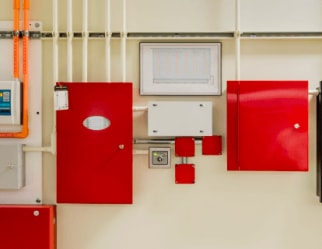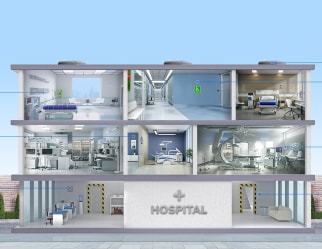According to the UK Health Security Agency (UKHSA), at least 40 people die and 4,000 visit the emergency room annually due to carbon monoxide poisoning in the United Kingdom. That’s why it’s important as an installer to know and understand the different types of carbon monoxide detectors you can offer to your customers, so they can promote a CO-free environment. Learn everything you need to know about carbon monoxide detectors, including available features, where they should be installed and more, in this simple guide.
What is carbon monoxide (CO)?
Carbon monoxide (CO) is a life-threatening, odorless and colorless gas that is highly lethal. It is produced when various fuels including coal, wood, charcoal, oil, kerosene, propane and natural gas are burned. Many common household items such as carbon-fuelled appliances (boilers, fires, heaters or flues), charcoal grills, and portable generators produce CO. In commercial buildings, equipment and machinery like gas furnaces and boilers, water heaters and HVAC systems are sources of carbon monoxide. When dangerous levels of CO accumulate in an enclosed area, people and animals are highly prone to CO poisoning.
Types of carbon monoxide detectors
Due to its undetectable state, many people are often unaware that they are being exposed to carbon monoxide. To avoid CO poisoning, the UK has made it mandatory for residential and commercial buildings to have carbon monoxide detectors installed in the appropriate areas. The UK regulations do not state a required type, so it can be battery-powered or wired in, but Government guidance recommends an alarm compliant with British Standards BS 50291.
Here are the common types of CO detectors that you should consider installing:
-
Battery-operated detectors – As the name suggests, battery-operated detectors run on the power of batteries and will alert the user when the battery is low. It is recommended that these batteries be replaced every six months, even if there are no warning beeps. Battery-operated detectors should be installed in residential homes that are not equipped with special wiring for hardwired detectors. Depending on the state or city, battery-operated detectors are only allowed in commercial buildings that are not considered new construction.
-
Hardwired detectors – Hardwired detectors require special wiring typically only found in recently renovated homes and commercial buildings. These detectors are equipped with a battery backup in case of a power outage. It is recommended to replace these batteries at least every six months or no longer than every year.
-
Plug-in detectors – Plug-in detectors are simple to install as they just need to be plugged into a standard AC wall outlet. This makes it a popular choice among people who want to avoid the installation process of a battery-operated or hardwired detector. Plug-in detectors are also equipped with backup batteries that should be changed every six months. These detectors are commonly used in residential applications since commercial buildings require heavy-duty detectors with stronger detection capabilities.
Another CO detector you can offer your customers is a combination smoke detector that serves as a 2-in-1 protector against carbon monoxide and smoke. These detectors are offered as hardwired or battery-operated. Similar to hardwired and plug-in detectors, hardwired combination smoke detectors will also be equipped with backup batteries in case of power outages.
Where should carbon monoxide detectors be installed?
Residential
For residential applications, carbon monoxide detectors should be installed in any room that has a fixed combustion appliance.
What type of alarm is required?
The regulations do not state a required type, so it can be battery-powered or wired in, but Government guidance recommends an alarm compliant with European Standard EN 50291, carries the CE mark and a mark of independent certification, and is marked with an end-of-life indicator. Where battery-powered alarms are selected, alarms with ‘sealed for life’ batteries rather than alarms with replaceable batteries are the better option.
Where should the alarm be installed?
Follow the individual manufacturer’s instructions when installing a smoke alarm. In general, carbon monoxide alarms should be positioned at head height, either on a wall or shelf, approximately 1-3 metres away from a potential source of carbon monoxide. It is also recommended that a detector is installed within 5 m (16 ft) of every bedroom.
Commercial
The Safety, Health and Welfare at Work (Chemical Agents) Regulations, 2001 (S.I. No. 619 of 2001) places duties on employers to ensure, so far as is reasonably practicable, the health and safety of their employees and that of persons not in their employment, such as customers, who may be affected by their business. This means that workers and members of the public must be protected from the risk of exposure to carbon monoxide gas, whether a business is in operation or not. Due to the more complex nature of commercial and industrial settings, a proper risk assessment and site survey should be conducted by a specialist team before detectors are installed to ensure compliance with the law.
Common features of carbon monoxide detectors
Although all carbon monoxide detectors will do the job of detecting CO, some detectors offer special features such as digital displays, voice alarms, wireless capabilities, hush buttons, smart features with Wi-Fi connectivity and more. Most commercial buildings and some residential homes will require the installation of CO detectors that can interconnect and simultaneously set off all alarms when one detector finds traces of CO. In a commercial setting, detection devices, including CO detectors, are designed to directly integrate with a fire panel system to ensure 24/7 monitoring and quick notification to the fire department if the detector sounds.
Maintenance and testing
To ensure a carbon monoxide detector functions properly, it should be tested monthly and maintained according to the manufacturer’s guidelines. To test a CO detector, press down the test button on the alarm and ensure the proper number of beeps are heard according to your specific model. It would be best if you also looked to replace CO detectors every five to seven years. Additionally, battery-operated CO detectors or detectors that hold backup batteries should be updated with new batteries at least every six months or every year, depending on the detector.
Carbon monoxide (CO) is a deadly, silent-killer gas that is undetectable and life-threatening to people and animals. To avoid poisoning or death from CO exposure, be sure to educate your customers about why it’s important to install CO smoke detectors throughout residential and commercial buildings. And as an installer, ensure you study and follow the respective state or city regulations when you install carbon monoxide detectors.







